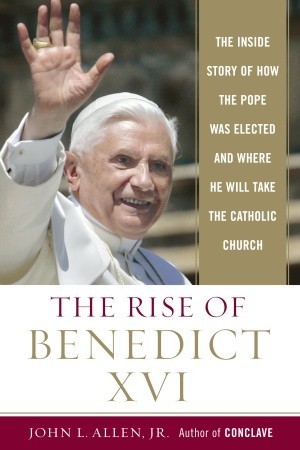In response to the badgering of reporters during the interregnum about whether the new pope would be a liberal or a conservative, Justin Cardinal Rigali of Philadelphia responded that the next pope will be Catholic. With the election of Joseph Cardinal Ratzinger as Pope Benedict XVI, the Church has not only a Catholic pope but one whose immense erudition and personal holiness guarantee a flourishing papacy. In The Rise of Benedict XVI, John Allen, Jr., the capable and well-informed Vatican correspondent for the National Catholic Reporter, provides a fair and balanced, if somewhat slipshod (no doubt reflecting the great haste of its composition), account of the elevation of Pope Benedict XVI and what may be expected from him during his reign.
The first half of Allen’s book is excellent reporting on the events surrounding the conclave. He begins with a poignant depiction of the death of Pope John Paul II, about whose papacy he offers a graceful appreciation. As dean of the College of Cardinals, Cardinal Ratzinger was at the center of all the events immediately following the demise of Pope John Paul II, and Allen demonstrates how this prominence led to the eventual election of Ratzinger as the 265th pope. Allen is absorbing on the rather complicated politics surrounding a papal election.
In the second half, Allen provides a biographical portrait of Ratzinger and an outline of the issues he will face. As often happens in our media-saturated age, even with the microscopic coverage of the election of Benedict XVI, the media portrait of him was, and remains, risibly wrong. The embarrassingly crude caricatures of Ratzinger as “God’s rottweiler” and the like could not be more false. Far from being a kind of Teutonic intellectual thug, Ratzinger is, as any reader of his elegant autobiography, Milestones, understands, one of the most brilliant men in the Church and—as he said upon his elevation—“a simple and humble worker in the vineyard of the Lord.”
Allen’s book eschews caricature. He instead gives us a sound and occasionally insightful sense of Benedict XVI’s character and his enduring theological concerns. Allen concisely identifies the core of this theology:
Fundamentally, Ratzinger has long been concerned that the Christian message, that God entered history in the person of Jesus Christ in order to mark out a path to salvation, one that does not vary with time or fashion, becomes jeopardized in a cultural environment that has largely abandoned the concept of objective truth.
The rejection of objective truth is a profound problem; in a homily on the day the conclave began, Ratzinger denounced what he called, in a striking phrase, the “dictatorship of relativism.” Politically and culturally, this relativism has devoured the heart and soul—not to mention the population—of Europe. As a young man growing up in Nazi Germany, Ratzinger witnessed first-hand the catastrophe of truth relativized and manipulated by ideology. More importantly, it threatens the very essence of Catholicism. Allen is astute in his summary of the problem:
Relativism is . . . not merely a modern version of ancient heresies such as Monophysitism or Pelagianism, which distort one or another element of the Church’s creed . . . it denies the possibility of objectively binding creedal statements in the first place.
The selection of Benedict as his papal name reflects the utterly critical need for moral and cultural renewal in Europe. Saint Benedict was, as Allen says, “the great founder of European monasticism,” and, at his first General Audience, Benedict XVI made this observation: “He constitutes a fundamental point of reference for the unity of Europe, and a powerful call to the irrefutable Christian roots of European culture and civilization.”
It has been a long time since the Throne of the Fisherman has been occupied by a theologian of the very first order. Benedict XVI certainly is one, and the story of his election and his vision for the Church is well told by Allen. Alas, he neglects any real discussion of Benedict XVI’s substantial body of theology. A good place to begin an exploration of this work would be the small classic On the Meaning of Christian Brotherhood. Also indispensable are the very influential Introduction to Christianity and the declaration from the Congregation for the Doctrine of the Faith entitled Dominus Iesus (Jesus the Lord). One will encounter in these works a breadth of knowledge, theological rigor, and doctrinal clarity and reliability that are astonishing. Habemus Papam, indeed.
[The Rise of Benedict XVI: The Inside Story of How the Pope was Elected and Where He Will Take the Catholic Church, by John L. Allen, Jr. (New York: Doubleday) 249 pp., $19.95]

Leave a Reply